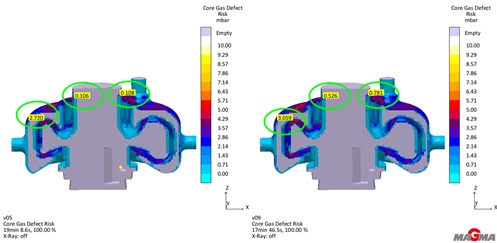Reducing core gas defects on cast parts
Of the several sand core production processes, the most common are “shell” and “cold-box”, for high productivity components. Both utilize sand mixed with a resin binder. The resign acts by granting hardness to the mix after the curing process.
During casting it is expected of the core enough hardness to keep itself sound during part of the process, however, at the same time, it must collapse at a given point so it can be removed from the cast part.
As of given temperatures the resign degrades, removing structural integrity, and the core collapses.
Due to resign degradation, a defect that bothers foundries is the entrapment of core gas, because if there is no well defined passage to the environment, this gas may be trapped within the casting - causing defects.
In version 5.4, a tool for calculating and comparing different venting systems was implemented. Through this tool it is possible to define vents that are placed in reality on the core and verify if they are enough to guarantee the part’s sanity. In Figure 1 bellow it is possible to verify the difference in core gas formation tendency on the core’s surface (core in grey) with an optimized and non optimized venting system. It can be observed that the reduction on the defect tendency is significant.
The use of this tool was explained by MAGMA Engenharia do Brasil in the Webinar that took place on May the 30th and July the 3rd.
*To access the links above it is necessary to be logged in the support area of the website.
